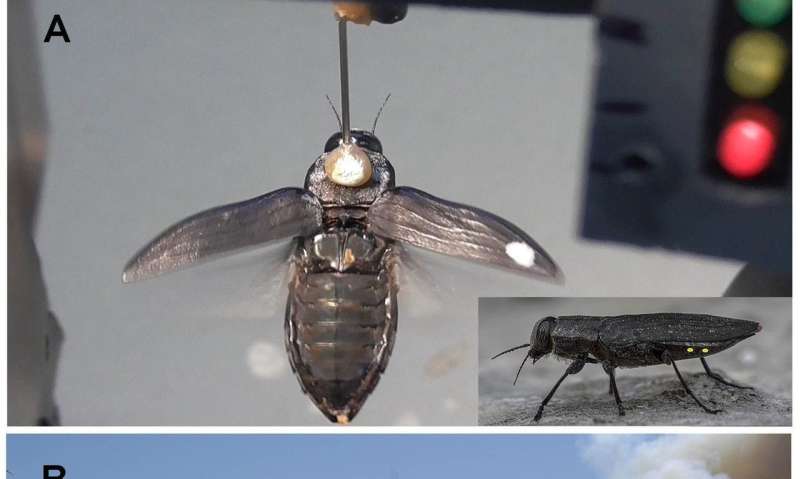Australian fire beetle avoids the heat

The Australian jewel beetle Merimna atrata has several heat sensors. Originally, it was thought to use them to detect forest fires as it lays its eggs in the wood of burned eucalyptus trees. Researchers at the University of Bonn have refuted this hypothesis. Instead, the beetle appears to need its heat sensors for a different purpose: to avoid burning its feet upon landing. The study has now been published in the journal PLOS ONE.
The Australian fire beetle is pyrophilliac, attracted to freshly burnt wood. This behavior is not very common in insects. Merimna atrata, however, has a good reason for this. The dead wood provides plenty of food for its larvae, so it uses the wood for oviposition.
But how does Merimna find a freshly burned area? For some time, it has been known that the fire beetle has heat sensors with which it can detect infrared radiation. In a sense, it "sees" hot places in its environment against a cooler background. It was originally believed that the insects use this ability to detect forest fires.
"However, the IR organs in Merimna atrata are relatively insensitive," says Dr. Helmut Schmitz. Schmitz is a lecturer at the Institute of Zoology at the University of Bonn. He has investigated thermo and infrared reception in the insects for nearly two decades. "This actually contradicts the assumption that the IR organs enable the beetle to detect fires from a greater distance."
Together with his colleagues, Schmitz has demonstrated for the first time that these doubts are justified. The scientists designed an ingenious experiment for this purpose.They stuck the beetles with their backs to the end of a pin, which they used to hang them up. This left the experimental animals with the ability to fly continuously without forward motion. "More importantly, they were able to navigate in any direction, i.e. turning right or left," says Schmitz.
Then the scientists stimulated the flying beetles with weak infrared radiation from the side. The beetles changed their flight direction in response, but always away from the source and never toward it.
"Merimna's IR organs are located on both sides of its abdomen; this is unique in the animal kingdom," says Schmitz. "When we occluded the IR receptors with aluminum foil, the animals no longer reacted to the radiation, but always carried on flying straight ahead. As soon as we removed the foil, they displayed their original behavior again."
This observation suggests another use of the heat sensors. "Presumably, they help the fire beetles avoid hot spots when approaching an oviposition site such as a freshly burnt branch. These hot spots are not visible with the naked eye to humans and animals during the day," says Schmitz.
How the animals detect forest fires remains unclear. Even visual stimuli seem to play no role in fire detection, despite the beetle's good eyesight. The researchers tested this hypothesis by showing them slides of large clouds of smoke rising above a forest area. But the insects were completely unimpressed and never changed their flight direction.
"We therefore assume that Merimna atrata gets its information about an ongoing fire from the smell of smoke," concludes Helmut Schmitz. This is also important for another reason. Odors can reveal what is actually burning. In contrast, this information cannot be inferred from the heat signature or the appearance of a smoke plume. Merimna is very picky, only laying its eggs in burnt eucalyptus wood and avoiding other trees. If the insect relies only on its IR sense, it would risk being lured into the wrong kinds of fires.
Something quite different can be seen with a close European relative; the fire beetles of the genus Melanophila. Their larvae develop in a variety of trees. Heat perception would be quite worthwhile for them. In fact, Melanophila also has infrared sensors, but they are completely different. They may detect infrared radiation even at long distances. According to measurements and theoretical calculations, Melanophila heat sensors are at least 500 times more sensitive than those of Merimna atrata.
More information: Marcel Hinz et al, The impact of infrared radiation in flight control in the Australian "firebeetle" Merimna atrata, PLOS ONE (2018). DOI: 10.1371/journal.pone.0192865
Journal information: PLoS ONE
Provided by University of Bonn


















